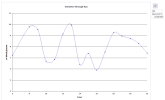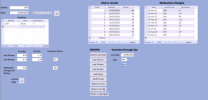Cheryl23711
Member
- Relationship to Diabetes
- Type 2
Can anyone tell me what is a reasonable number for blood glucose shortly after eating and how quickly it should return to the 5-7 range please?

Thank you. T2 < 8.5 is achievable I think. Working hard to get there.In a non diabetic it should return to normal between 2 and 3 hours after eating. At 2 hours < 7.8 is a good response.
For T2 the aim is to be < 8.5 two hours after eating.
I’m very out of practice with spreadsheets, it’s been a while however, I do have a friend who can help with that. So far, I’ve kept a sort of blog/diary of data, adding any info I deemed relevant such as ‘10 mile bike ride’, or the time at which I took metformin. I think it will make interesting reading once on a flow chart.@Cheryl23711 - no problem trying to replicate. Do you know your way round a spreadsheet? If so, I'll tell you how I did it. One thing you need to do is to vary the time at which you take readings so that you get a decent spread of data through the day. Also i did not take readings "on the hour", I noted the exact time and rounded it to the nearest hour whilst manipulating the data and there were 320 readings in total.
I’ve decided to change my eating habits so that I only have food when stats drop between 5-7 ( they never seem to drop as low as 4). I’m a bit odd in that I can stop eating at 6pm, go to bed at 10 with a reading of 8.5 or less and still be raised up at 8.9 -9.5 first thing, before having anything to eat or drink. So, I decided a week ago that I would not eat until those numbers came down within range, which they usually do by about 12.30.In type 2 diabetes the ‘first phase’ insulin response can become impaired so that it does not fire as expected. This can lead to a fairly sharp rise in glucose values immediately after eating, but once the ‘second phase’ insulin is released these begin to come down by the 2hr mark.
Some people aim to modify their diet based on what they determine as their peak glucose response time (which can vary from person to person) while others are happy to check at 2hrs after meals as any elevated glucose levels will have beem fairly short lived.
One rule of thumb popular on the forum is to aim for either 8.5mmol/L as a maximum, or a rise of no more than 2-3mmol/L between 2 readings, one immediately before eating and the second at 2hrs after the first bite. The second method can help in the early days where levels before meals may remain quite high.
Eg starting at 9.2, and rising to 11.3. Now on the face of it 11.3 looks less than ideal, but the meal only raised glucose by 2.1, and once the person‘s overall levels have gradually fallen it would only take a premeal reading of 6.0 to 8.1 at 2hrs - which would be ideal!
I can see the logic behind your thinking, but my morning readings are often higher than the previous evening, but if they were 8 before food at say 7am, then they are usually 5/6 two hours later. I believe they call this the “dawn phenomenon “ or foot on the floor, when your body wants to supply energy to the cells for the day ahead.I’ve decided to change my eating habits so that I only have food when stats drop between 5-7 ( they never seem to drop as low as 4). I’m a bit odd in that I can stop eating at 6pm, go to bed at 10 with a reading of 8.5 or less and still be raised up at 8.9 -9.5 first thing, before having anything to eat or drink. So, I decided a week ago that I would not eat until those numbers came down within range, which they usually do by about 12.30.
Not at all odd actually. This is a normal circadian response which as mentioned above, is known as Dawn Phenomenon or it's slightly more colloquial name of Foot on the Floor syndrome, where the liver pumps out glucose to give us energy for the day ahead. Interestingly, eating something should stop this function of the liver, so not eating till lunch time may be less helpful that eating something straight away, because food entering the stomach can trigger both the off switch to the liver and the on switch to the pancreas to release insulin to bring levels down. However we are all different particularly with diabetes and what should work, will work for some people but not for others, so you have to play about with trying different things to see what works for you as an individual. Some people find that eating a low carb snack like a few nuts as soon as they wake up, stops the liver from releasing this glucose. Some people find that exercising on an evening, helps to bring morning levels down, or exercising on a morning to use up that glucose that the liver is releasing.I’ve decided to change my eating habits so that I only have food when stats drop between 5-7 ( they never seem to drop as low as 4). I’m a bit odd in that I can stop eating at 6pm, go to bed at 10 with a reading of 8.5 or less and still be raised up at 8.9 -9.5 first thing, before having anything to eat or drink. So, I decided a week ago that I would not eat until those numbers came down within range, which they usually do by about 12.30.
OK... here goes with my approach. Complicated a little because I put all my data into an Access database but the principles are the same.I’m very out of practice with spreadsheets, it’s been a while however, I do have a friend who can help with that. So far, I’ve kept a sort of blog/diary of data, adding any info I deemed relevant such as ‘10 mile bike ride’, or the time at which I took metformin. I think it will make interesting reading once on a flow chart.

This is a very informative response, thank you. My doctor has suggested I go for further liver function tests due to raised ALT levels so this all adds up. I’d never been told about the dawn phenomenon so was thinking I was just an odd ball . Moreover, I’m not sure the medical people I’m working with have either, I shall be enlightening them. I have to say, the things people on here know is actually very reassuring. Thank you again.Not at all odd actually. This is a normal circadian response which as mentioned above, is known as Dawn Phenomenon or it's slightly more colloquial name of Foot on the Floor syndrome, where the liver pumps out glucose to give us energy for the day ahead. Interestingly, eating something should stop this function of the liver, so not eating till lunch time may be less helpful that eating something straight away, because food entering the stomach can trigger both the off switch to the liver and the on switch to the pancreas to release insulin to bring levels down. However we are all different particularly with diabetes and what should work, will work for some people but not for others, so you have to play about with trying different things to see what works for you as an individual. Some people find that eating a low carb snack like a few nuts as soon as they wake up, stops the liver from releasing this glucose. Some people find that exercising on an evening, helps to bring morning levels down, or exercising on a morning to use up that glucose that the liver is releasing.
With non-diabetic people the pancreas releases enough insulin to deal with the glucose than the liver releases, so they don't really see this Dawn Phenomenon to any great extent, but as diabetics, that insulin release is less effective, so BG levels can rise quite significantly. Mine can increase by 4-6mmols between waking up and an hour later, unless I inject insulin to deal with it the minute I wake up and before I set foot out of bed.
Thank you for this. Once I have more data, I shall definitely be having a go.OK... here goes with my approach. Complicated a little because I put all my data into an Access database but the principles are the same.
1. You need to get results from different times through the day. You will no doubt have waking and nightime readings together with some pre and post meal readings. Take readings at other odd times - no need for anything too systematic.
2. Take note of date, time and BG reading for each test. I use a pen and note book for this.
3. Enter data into spreadsheet in three columns, DATE, TIME, BLOOD GLUCOSE.
4. In a fourth column, labelled HOUR, enter the time rounded to the nearest hour. Various ways you can do this either by devising your own formula or by using whatever ROUND() functions exist in the spreadsheet you are using.
5. Create a PIVOT TABLE from the HOUR and BLOOD GLUCOSE columns to give the average blood glucose for each hour of the day.
6. Draw a graph of HOUR and Average BLOOD GLUCOSE from the results in the pivot table.
As I say I use a database rather than a spreadsheet because data entry can be made much easier and once you have worked out what you want to do with the data, automation of tasks is much more straightforward.
View attachment 27169
This is my home page. Data entry at the top with all the outputs at the bottom. Bottom left are various averages and predictions, clicking on the various tags under GRAPHS will give me all sorts of graphs and Under Variation through the day I can change the period over which the variation through the day graph can be plotted.
Have fun!
Go for it!Thank you for this. Once I have more data, I shall definitely be having a go.
